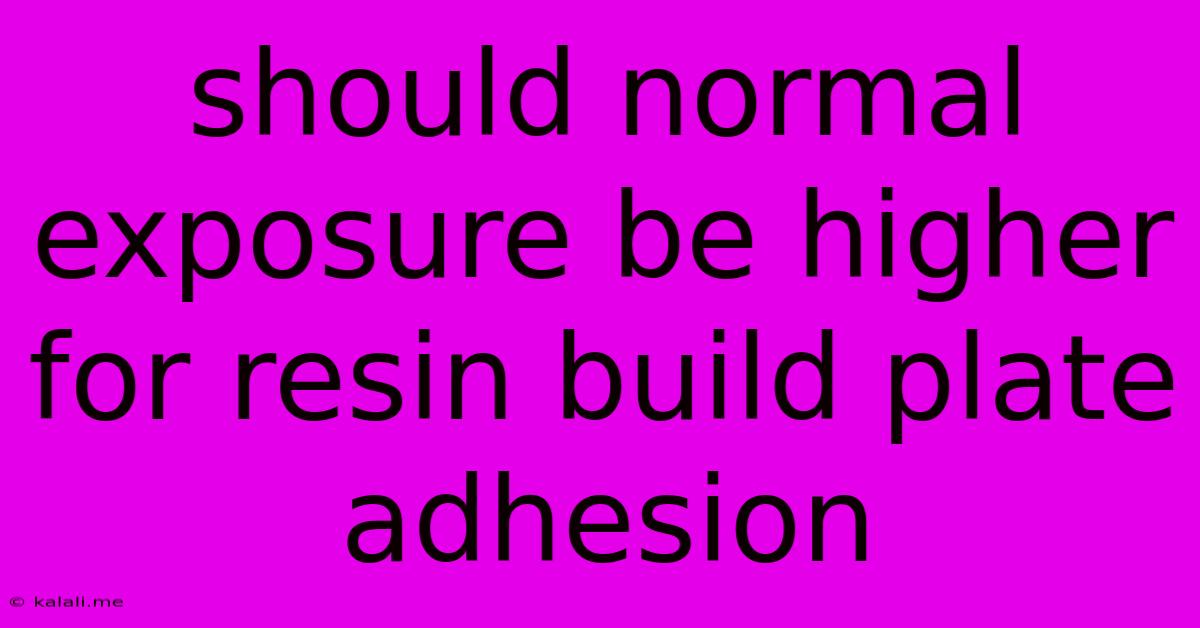Should Normal Exposure Be Higher For Resin Build Plate Adhesion
Kalali
Jun 04, 2025 · 3 min read

Table of Contents
Should Normal Exposure Be Higher for Resin Build Plate Adhesion?
Meta Description: Struggling with resin prints not sticking to the build plate? This article explores whether increasing normal exposure time improves adhesion in resin 3D printing, examining the pros, cons, and best practices.
Resin 3D printing offers incredible detail and precision, but achieving a consistently successful print hinges on proper adhesion to the build plate. One common troubleshooting step involves adjusting the "normal exposure" setting in your printer's software. But should you actually increase it to improve adhesion? The answer isn't a simple yes or no. Let's delve into the complexities of this setting and its impact on print success.
Understanding Normal Exposure in Resin 3D Printing
Normal exposure refers to the amount of UV light exposure each layer receives during the curing process. This crucial parameter directly affects the polymerization of the resin, transforming the liquid into a solid. Insufficient exposure can lead to under-cured layers, while excessive exposure might result in over-cured, brittle prints. The "normal exposure" setting usually applies to the majority of your print layers, excluding the first layer (which often has a separate, longer exposure time).
The Relationship Between Normal Exposure and Adhesion
Increasing normal exposure can sometimes improve adhesion. A slightly longer cure time allows for more complete polymerization at the base of each layer, creating a stronger bond with the layer below and, ultimately, the build plate. This is particularly beneficial when using resins known for their lower viscosity or when dealing with intricate, small details that might otherwise detach.
Potential Drawbacks of Increasing Normal Exposure
While increasing normal exposure might seem like a simple solution, it's essential to consider the potential drawbacks:
- Increased Print Time: Higher exposure times directly translate to longer overall print times. This can significantly impact your workflow and productivity.
- Increased Resin Consumption: Over-curing can lead to slightly more resin being used per layer, increasing material costs.
- Increased Heat Generation: Prolonged exposure to UV light generates heat. Excessive heat can potentially damage the resin, leading to warping or other print defects.
- Potential for Over-Curing: Over-curing can make the printed parts brittle and prone to cracking. This outweighs the benefits of increased adhesion.
Best Practices for Optimizing Adhesion Without Over-Exposing
Instead of solely relying on increasing normal exposure, consider these alternative approaches for improving adhesion:
- Proper Resin Selection: Choose a resin specifically designed for your printer and the intended application. Some resins are formulated for superior adhesion.
- Clean Build Plate: Always ensure your build plate is meticulously cleaned before each print. Residues from previous prints can significantly hinder adhesion.
- Proper Leveling: A perfectly level build plate is crucial. Improper leveling can create inconsistencies in resin thickness, leading to adhesion issues.
- Appropriate First Layer Exposure: Pay close attention to your first layer exposure settings. This is often the most critical factor in achieving strong initial adhesion.
- Using an Adhesion Promoter: Certain sprays or coatings can significantly improve the bond between the resin and the build plate.
- Temperature Control: Maintain a consistent ambient temperature during printing, as temperature fluctuations can affect resin viscosity and adhesion.
Conclusion
Increasing normal exposure might help with resin build plate adhesion, but it's not a guaranteed solution, and often comes with undesirable consequences. Before adjusting this setting, systematically explore other potential causes for poor adhesion such as those listed above. A holistic approach focusing on proper resin selection, meticulous cleaning, perfect leveling, and appropriate first layer exposure will likely yield far better and more consistent results than simply increasing exposure time. Remember that finding the optimal settings for your specific printer, resin, and environment requires experimentation and careful observation.
Latest Posts
Latest Posts
-
How Long Does Espresso Last In The Fridge
Jun 06, 2025
-
Conver Row To Column Google Sheets
Jun 06, 2025
-
How To Ground An Outlet With Only 2 Wires
Jun 06, 2025
-
How To Pronounce Nihilistic In English
Jun 06, 2025
-
How To Get Feral Cats To Trust You
Jun 06, 2025
Related Post
Thank you for visiting our website which covers about Should Normal Exposure Be Higher For Resin Build Plate Adhesion . We hope the information provided has been useful to you. Feel free to contact us if you have any questions or need further assistance. See you next time and don't miss to bookmark.